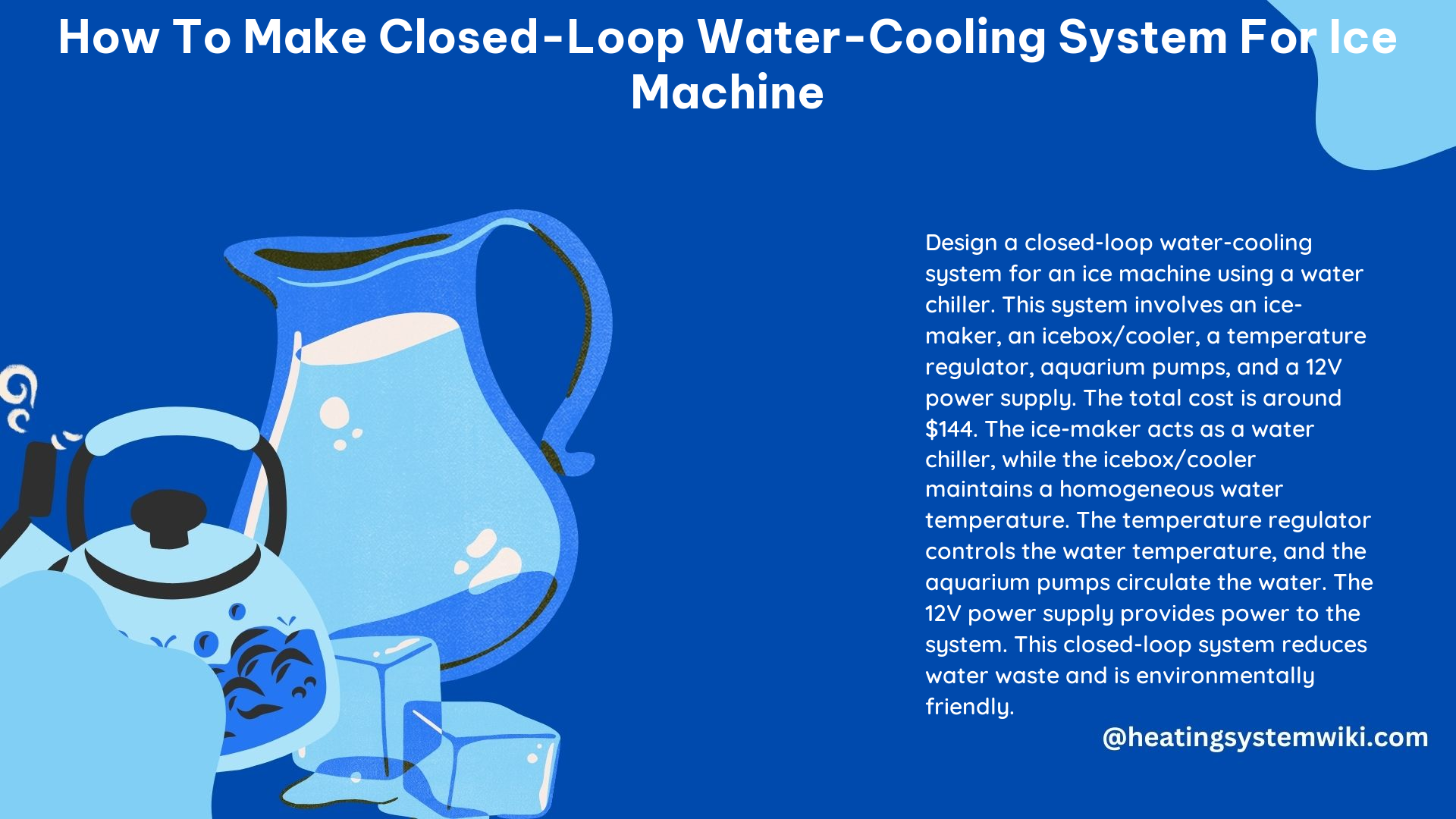Creating a closed-loop water-cooling system for an ice machine can help reduce water waste and improve the overall efficiency of the refrigeration process. This step-by-step guide will provide you with the technical details and considerations needed to build a DIY closed-loop water-cooling system for your ice machine.
Choosing the Right Components
Container
The first step is to select a suitable container to serve as the water reservoir. A 5-gallon bucket or an insulated icebox/cooler are common choices. The container should be clean, free of contaminants, and able to hold the required volume of water.
Water Pump
The water pump is responsible for circulating the water from the reservoir through the ice machine’s condenser and back. An aquarium pump or a submersible pump with a flow rate and pressure suitable for your ice machine’s condenser specifications should be used. For example, a 1/6 HP (125 GPH) submersible pump can effectively circulate water in a closed-loop system for a small commercial ice machine.
Temperature Regulator
To maintain the water temperature within the optimal range, typically 60-70°F (15-21°C), a temperature regulator or aquarium heater should be installed. This helps ensure the condenser can efficiently remove heat from the refrigeration process.
Tubing and Hoses
The water pump’s output should be connected to the ice machine’s condenser using appropriate tubing or hoses. The connections must be secure and leak-free to prevent water loss and potential damage to the system.
Assembling the Closed-Loop System

-
Set up the Container: Place the 5-gallon bucket or insulated icebox/cooler in a suitable location near the ice machine. Ensure the container is level and stable.
-
Install the Water Pump: Submerge the water pump in the container, making sure the intake is fully submerged. Connect the pump’s output to the ice machine’s condenser using the appropriate tubing or hoses.
-
Connect the Temperature Regulator: Install the temperature regulator or aquarium heater in the water reservoir, ensuring the heating element is fully submerged. Connect the regulator’s output to the water reservoir.
-
Wire the Components: Wire the water pump and temperature regulator according to their respective specifications, ensuring proper polarity and voltage. Use waterproof connections and heat-shrink tubing to prevent leaks and ensure the longevity of the system.
-
Plumb the System: Securely connect the water pump’s output to the ice machine’s condenser using the appropriate tubing or hoses. Ensure all connections are tight and leak-free.
-
Test the System: Start the water pump and temperature regulator, and monitor the water temperature and flow rate. Adjust the temperature regulator as needed to maintain the desired water temperature.
Maintaining the Closed-Loop System
-
Monitor Water Level: Regularly check the water level in the reservoir and refill as needed to maintain the proper water volume.
-
Check Pump Performance: Inspect the water pump for any signs of wear or damage, and clean or replace it as necessary to ensure optimal performance.
-
Maintain Temperature Regulator: Periodically check the temperature regulator’s operation and clean or replace the heating element if it becomes fouled or damaged.
-
Inspect Connections: Regularly inspect all tubing and hose connections for any leaks or wear, and tighten or replace them as needed to prevent water loss and potential damage.
Technical Specifications and Considerations
Container: 5-gallon bucket or insulated icebox/cooler with a capacity of at least 5 gallons (18.9 liters)
Water Pump: Aquarium pump or submersible pump with a flow rate of at least 125 GPH (473 LPH) and a minimum pressure of 10 PSI (0.69 bar)
Temperature Regulator: Aquarium heater or temperature regulator with an adjustable temperature range of 60-70°F (15-21°C)
Tubing/Hoses: Appropriate for the water pump and ice machine’s condenser connections, typically 1/2″ (12.7 mm) or 3/4″ (19.05 mm) diameter
Safety Considerations:
– Ensure proper electrical connections and grounding to prevent shock hazards
– Use waterproof components and connections to avoid leaks and water damage
– Follow manufacturer’s instructions and safety guidelines for each component
Efficiency Considerations:
– Design the system to minimize energy consumption and water waste while maintaining optimal cooling performance
– Monitor the system’s performance and make adjustments as needed to maintain efficiency
Cost Considerations:
– The total cost of the DIY closed-loop water-cooling system will depend on the specific components used
– Expect to spend around $144 for the components mentioned in the sources, including the container, water pump, temperature regulator, and necessary tubing/hoses
